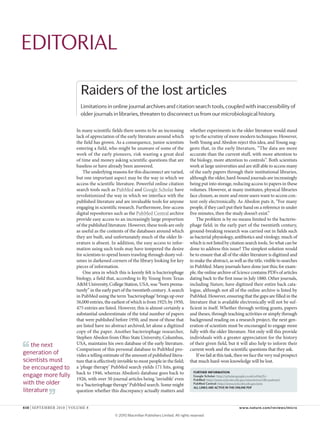Contenu connexe
Similaire à Raiders of the lost articles (20)
Plus de Alfonso Enrique Islas Rodríguez (20)
Raiders of the lost articles
- 1. EditoriaL
Raiders of the lost articles
Limitations in online journal archives and citation search tools, coupled with inaccessibility of
older journals in libraries, threaten to disconnect us from our microbiological history.
In many scientific fields there seems to be an increasing whether experiments in the older literature would stand
lack of appreciation of the early literature around which up to the scrutiny of more modern techniques. However,
the field has grown. As a consequence, junior scientists both Young and Abedon reject this idea, and Young sug-
entering a field, who might be unaware of some of the gests that, in the early literature, “The data are more
work of the early pioneers, risk wasting a great deal accurate than the current stuff, with more attention to
of time and money asking scientific questions that are the biology, more attention to controls”. Both scientists
baseless or have already been answered. work at large universities and are still able to access many
The underlying reasons for this disconnect are varied, of the early papers through their institutional libraries,
but one important aspect may be the way in which we although the older, hard-bound journals are increasingly
access the scientific literature. Powerful online citation being put into storage, reducing access to papers in these
search tools such as PubMed and Google Scholar have volumes. However, at many institutes, physical libraries
revolutionized the way in which we interface with the face closure, as more and more users want to access con-
published literature and are invaluable tools for anyone tent only electronically. As Abedon puts it, “For many
engaging in scientific research. Furthermore, free-access people, if they can’t put their hand on a reference in under
digital repositories such as the PubMed Central archive five minutes, then the study doesn’t exist.”
provide easy access to an increasingly large proportion The problem is by no means limited to the bacterio-
of the published literature. However, these tools are only phage field; in the early part of the twentieth century,
as useful as the contents of the databases around which ground-breaking research was carried out in fields such
they are built, and unfortunately much of the older lit- as bacterial physiology, antibiotics and virology, much of
erature is absent. In addition, the easy access to infor- which is not listed by citation search tools. So what can be
mation using such tools may have tempered the desire done to address this issue? The simplest solution would
for scientists to spend hours trawling through dusty vol- be to ensure that all of the older literature is digitized and
umes in darkened corners of the library looking for key to make the abstract, as well as the title, visible to searches
pieces of information. in PubMed. Many journals have done just this; for exam-
One area in which this is keenly felt is bacteriophage ple, the online archive of Science contains PDFs of articles
biology, a field that, according to Ry Young from Texas dating back to the first issue in July 1880. Other journals,
A&M University, College Station, USA, was “born prema- including Nature, have digitized their entire back cata-
turely” in the early part of the twentieth century. A search logue, although not all of the online archive is listed by
in PubMed using the term ‘bacteriophage’ brings up over PubMed. However, ensuring that the gaps are filled in the
56,000 entries, the earliest of which is from 1925; by 1950, literature that is available electronically will not be suf-
475 entries are listed. However, this is almost certainly a ficient in itself. Whether through writing grants, papers
substantial underestimate of the total number of papers and theses, through teaching activities or simply through
that were published before 1950, and most of those that background reading on a research project, the next gen-
are listed have no abstract archived, let alone a digitized eration of scientists must be encouraged to engage more
copy of the paper. Another bacteriophage researcher, fully with the older literature. Not only will this provide
Stephen Abedon from Ohio State University, Columbus, individuals with a greater appreciation for the history
the next USA, maintains his own database of the early literature. of their given field, but it will also help to inform their
Comparison of this personal database to PubMed pro- current work and the scientific questions that they ask.
generation of vides a telling estimate of the amount of published litera- If we fail at this task, then we face the very real prospect
scientists must ture that is effectively invisible to most people in the field; that much hard-won knowledge will be lost.
be encouraged to a ‘phage therapy’ PubMed search yields 171 hits, going
back to 1946, whereas Abedon’s database goes back to FURTHER INFORMATION
engage more fully Google Scholar: http://scholar.google.co.uk/schhp?lr=
1926, with over 50 journal articles being ‘invisible’ even PubMed: http://www.ncbi.nlm.nih.gov/sites/entrez?db=pubmed
with the older to a ‘bacteriophage therapy’ PubMed search. Some might PubMed Central: http://www.ncbi.nlm.nih.gov/pmc
All links Are Active in the online pdf
literature question whether this discrepancy actually matters and
610 | SePTeMBeR 2010 | VOlUMe 8 www.nature.com/reviews/micro
© 2010 Macmillan Publishers Limited. All rights reserved

